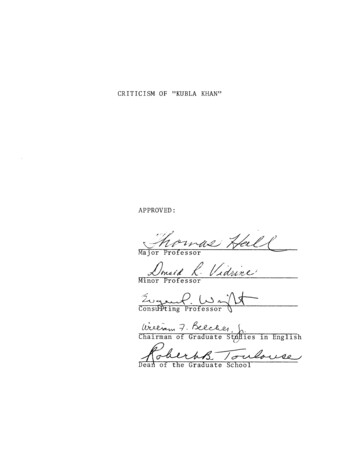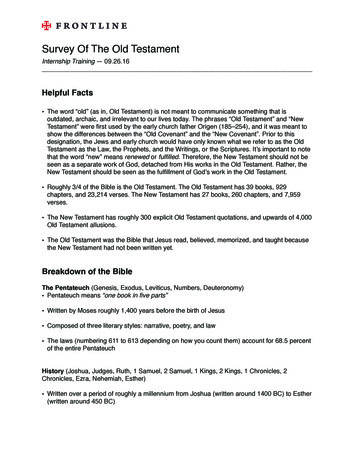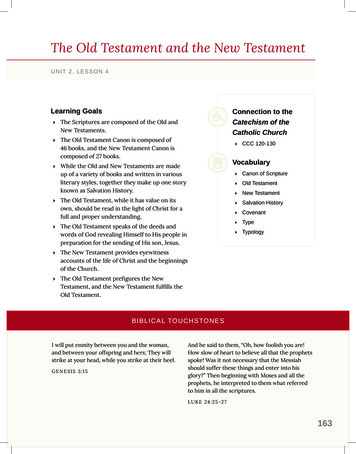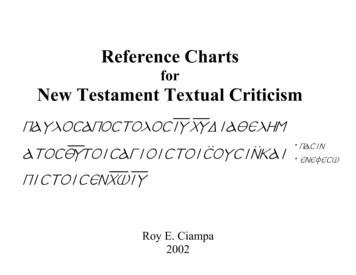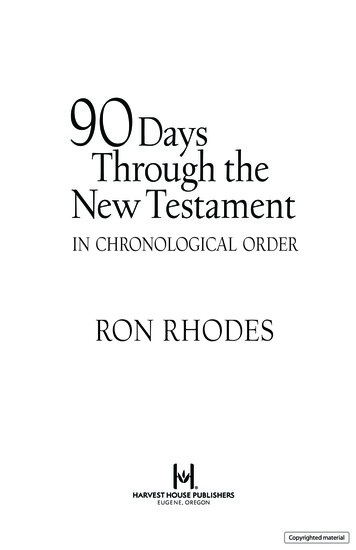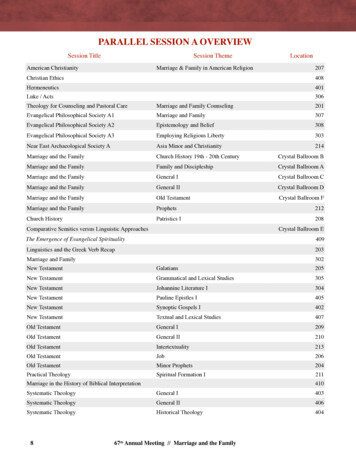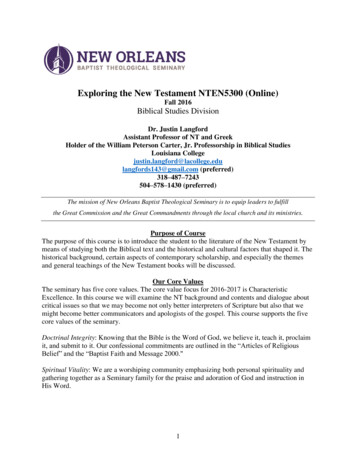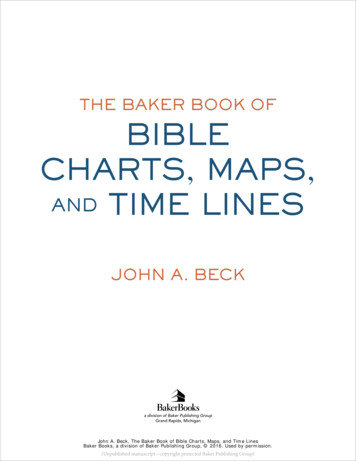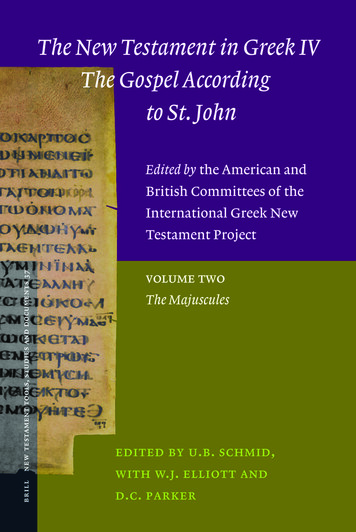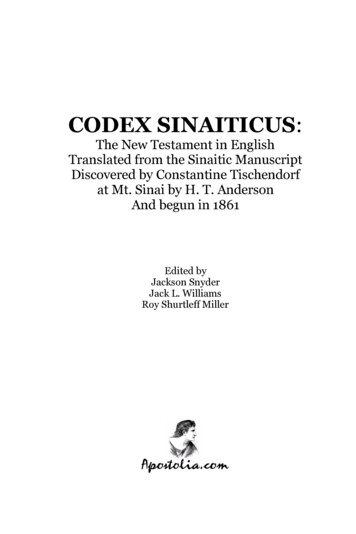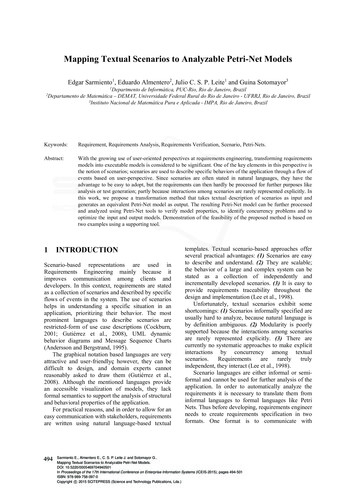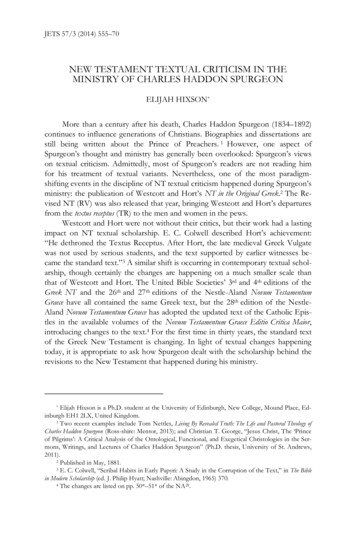
Transcription
JETS 57/3 (2014) 555–70NEW TESTAMENT TEXTUAL CRITICISM IN THEMINISTRY OF CHARLES HADDON SPURGEONELIJAH HIXSON*More than a century after his death, Charles Haddon Spurgeon (1834–1892)continues to influence generations of Christians. Biographies and dissertations arestill being written about the Prince of Preachers. 1 However, one aspect ofSpurgeon’s thought and ministry has generally been overlooked: Spurgeon’s viewson textual criticism. Admittedly, most of Spurgeon’s readers are not reading himfor his treatment of textual variants. Nevertheless, one of the most paradigmshifting events in the discipline of NT textual criticism happened during Spurgeon’sministry: the publication of Westcott and Hort’s NT in the Original Greek.2 The Revised NT (RV) was also released that year, bringing Westcott and Hort’s departuresfrom the textus receptus (TR) to the men and women in the pews.Westcott and Hort were not without their critics, but their work had a lastingimpact on NT textual scholarship. E. C. Colwell described Hort’s achievement:“He dethroned the Textus Receptus. After Hort, the late medieval Greek Vulgatewas not used by serious students, and the text supported by earlier witnesses became the standard text.”3 A similar shift is occurring in contemporary textual scholarship, though certainly the changes are happening on a much smaller scale thanthat of Westcott and Hort. The United Bible Societies’ 3rd and 4th editions of theGreek NT and the 26th and 27th editions of the Nestle-Aland Novum TestamentumGraece have all contained the same Greek text, but the 28th edition of the NestleAland Novum Testamentum Graece has adopted the updated text of the Catholic Epistles in the available volumes of the Novum Testamentum Graece Editio Critica Maior,introducing changes to the text.4 For the first time in thirty years, the standard textof the Greek New Testament is changing. In light of textual changes happeningtoday, it is appropriate to ask how Spurgeon dealt with the scholarship behind therevisions to the New Testament that happened during his ministry.* Elijah Hixson is a Ph.D. student at the University of Edinburgh, New College, Mound Place, Edinburgh EH1 2LX, United Kingdom.1 Two recent examples include Tom Nettles, Living By Revealed Truth: The Life and Pastoral Theology ofCharles Haddon Spurgeon (Ross-shire: Mentor, 2013); and Christian T. George, “Jesus Christ, The ‘Princeof Pilgrims’: A Critical Analysis of the Ontological, Functional, and Exegetical Christologies in the Sermons, Writings, and Lectures of Charles Haddon Spurgeon” (Ph.D. thesis, University of St. Andrews,2011).2 Published in May, 1881.3 E. C. Colwell, “Scribal Habits in Early Papyri: A Study in the Corruption of the Text,” in The Biblein Modern Scholarship (ed. J. Philip Hyatt; Nashville: Abingdon, 1965) 370.4 The changes are listed on pp. 50*–51* of the NA28.
556JOURNAL OF THE EVANGELICAL THEOLOGICAL SOCIETYIn his recent biography, Tom Nettles describes Spurgeon’s attitude towardtextual criticism as “a robust appreciation.” 5 Citing a college address given bySpurgeon, Nettles captures the reason for Spurgeon’s “robust appreciation” oftextual criticism: “provided we have the exact text, we regard the words themselvesas infallible.”6 Spurgeon appreciated textual criticism because of his high view ofScripture.7This article seeks to understand better how Spurgeon used NT textual criticism in his ministry and to present Spurgeon as a model for contemporary ministers and scholars through an analysis of his remarks on textual variants and criticaleditions of the NT. An examination of Spurgeon’s works reveals that, although helived in an age dominated by the King James, or Authorized Version (AV), he wasaware of variant readings in the NT manuscripts.8 Spurgeon favored a critical textof the NT and discussed textual variants publicly, and his views began to developmuch earlier than the 1881 publication of Westcott and Hort’s NT in the OriginalGreek. He was an independent thinker who examined the evidence for each variantand came to his own conclusions on the original text.I. SPURGEON’S DISCUSSIONS OF NT TEXTUAL VARIANTSIn general, Spurgeon’s position was that textual variants should be addressedwhen needed, but should be left alone when not. His advice to his students wasthus:Do not needlessly amend our authorized version. It is faulty in many places, but still it isa grand work taking it for all in all, and it is unwise to be making every old ladydistrust the only Bible she can get at, or what is more likely, mistrust you forfalling out with her cherished treasure. Correct where correction must be fortruth’s sake, but never for the vainglorious display of your critical ability.9Spurgeon warned his students against “insinuating doubts concerning the authenticity of texts,” recalling a “painful” sermon he once heard, the entirety of whichcentered on the textual variant of the angel stirring up the waters of the pool inNettles, Living By Revealed Truth 181.C. H. Spurgeon, “The Need of Decision for the Truth,” The Sword and the Trowel 10 (1874) 103.For the purposes of brevity, references to The Sword and the Trowel will be given henceforth as S&T.7 For Spurgeon, NT textual criticism was important because it sought the original text of the NT.Since Spurgeon, many textual critics have shifted away from this goal. For a discussion, see Michael W.Holmes, “From ‘Original Text’ to ‘Initial Text’: The Traditional Goal of NT Textual Criticism in Contemporary Discussion,” in The Text of the NT in Contemporary Research: Essays on the Status Quaestionis (ed.Bart D. Ehrman and Michael W. Holmes; 2d ed.; NT Tools, Studies, and Documents 42; Leiden: Brill,2012) 637–88.8 “We know that in any one version of [the Bible] there may be minor errors of copyists, whichcould not have been avoided unless a miracle had been wrought every day for thousands of years” (S&T18 [1882] 162).9 C. H. Spurgeon, “On Commenting,” in Commenting and Commentaries (Passmore & Alabaster: London, 1893; repr. Pasadena, TX: Pilgrim, 1990) 31, italics his.56
NEW TESTAMENT TEXTUAL CRITICISM557Bethesda in John 5:4.10 Nevertheless, Spurgeon did not avoid textual variants; rather, he discussed them from the pulpit.Spurgeon’s attitude toward the RV reveals a general preference for the AV,but it is important to understand why Spurgeon favored the AV over the RV. Asdemonstrated below, Spurgeon often supported the critical text underlying the RV.However, Spurgeon disliked the RV as an English translation.11 In a review of TheStudent’s Concordance to the Revised Version of the NT, he said:Is the [AV] better? We think it is in many respects; but the Revised Version hasits advantages, and it is assuredly a great help to the English reader if he uses itby way of reference. We hope we shall never hear the New Version read fromthe pulpit in place of the old, for it has a foreign, un-English sound about it. Oh,that there had been on the committee one man of pure Saxon speech!12Considering the immense size of his works, Spurgeon spent comparatively little time addressing textual variants in the NT. Spurgeon was not a text critic, nordid he ever claim to be. 13 Nevertheless, Spurgeon did address textual variantsenough to expose his view of the original text of the NT. A list of forty instances inwhich Spurgeon dealt with variants in some form or another in his works is attached as an appendix. Many of these are insignificant—nineteen are instances inwhich Spurgeon treated each variant as if it were a mere difference in translation,often appealing to the Revised Version.14 Nevertheless, the following instances aresignificant enough to merit detailed discussions. The format is as follows: theGreek text, according to the textus receptus (TR) is given15 along with the English ofthe AV, followed by the manuscript support of the TR reading according to the28th edition of the Nestle-Aland Novum Testamentum Graece. The textual variant is10 C. H. Spurgeon, “Sermons—Their Matter,” in Lectures to My Students, first series (Passmore andAlabaster: London, 1881; repr. Pasadena, TX: Pilgrim, 1990) 79.11 For a treatment, see Doug Kutilek, “An Answer to David Otis Fuller: Fuller’s Deceptive Treatment of Spurgeon Regarding the King James Version,” in The Charles H. Spurgeon Collection (Version 2.3,AGES Software, Inc., 1998–2004) 1–21. A version of this article can also be found online athttp://www.kjvonly.org/doug/kutilek david otis fuller.htm [accessed 14 December 2013]. Kutilekcites Spurgeon on 1 John 3:1 and Luke 4:18 and gives several references of other instances in whichSpurgeon rejected the reading of the AV. However, Kutilek’s purpose is not to analyze Spurgeon’s useof NT textual criticism but to prove that Spurgeon was not AV-only.12 S&T 18 (1882) 545; see also reviews in S&T 17 (1881) 418 and S&T 22 (1886) 500.13 Concerning the variant in Luke 4:18, he said, “I began to ask whether the omission was a correctone or not; and, without making pretense to scholarship, I feel convinced that the revisers are actinghonestly in leaving it out” (“Heart-Disease Curable,” in The Metropolitan Tabernacle Pulpit 27 [1881] 341).Citations from the Metropolitan Tabernacle Pulpit are henceforth abbreviated as MTP and given withoutreference to the particular sermon from which the citation comes.14 Based on Spurgeon’s advice to students about needlessly amending the AV, it seems that whenSpurgeon presented variants as mere differences in translation, he did so as a pastor, not as a critic. Thiswas to keep from casting needless doubt on the text of the Bible in the minds of his hearers. Nevertheless, he did “correct where correction must be for truth’s sake” (see Commenting and Commentaries 31,quoted above) and the test passages considered here are examples of his corrections.15 Specifically,: The NT: The Greek Text Underlying the English Authorised Version of 1611 (London: Trinitarian Bible Society, n.d.). The text is essentially the same as F. H. A. Scrivener’s 1894 edition of the TR.
558JOURNAL OF THE EVANGELICAL THEOLOGICAL SOCIETYgiven below along with an English translation, followed by its manuscript supportaccording to the NA28. The manuscript support is included only for the benefit ofthe reader, and it should not be assumed that Spurgeon had the same evidence athis disposal.161. Luke 22:43–44.TR:.,. (And there appeared anangel unto him from heaven, strengthening him. And being in anagony he prayed more earnestly: and his sweat was as it were greatdrops of blood falling down to the ground.)*,2b, D, K, L, Q, , , ,, 0171vid, f1, 565, 700, 892, 1241, 1424,2542, M, lat, syc,p,h**, bopt, Ju, Ir, Hipp, Eus, HiermssVariant:[omit vv. 43–44]P75, 2a, A, B, N, T, W, 579, 844, (f13 places after Matt. 26:39), f, sys,sa, bopt, HiermssSpurgeon did not always depart from the TR, and the Lukan Gethsemanescene is one instance of this. A quick search of his works for the phrase “bloodysweat” yields ninety-two hits, and that does not account for variation in the waySpurgeon phrased his references to the event. Spurgeon unquestionably believedthis passage to be genuine.Over a century before Bart Ehrman’s monograph on theologically motivatedchanges to the NT text, Spurgeon suggested that the omission of vv. 43–44 was an“orthodox corruption” of the original text in Luke 22.17 He told his congregation:How extraordinary it seems that he, who is “very God of very God,” should become so weak as to need to be sustained by angelic agency! This struck someof the older saints as being derogatory to his divine dignity; so some manuscripts of the New Testament omit the passage; it is supposed that the verse wasstruck out by some who claimed to be orthodox, lest, perhaps, the Ariansshould lay hold upon it, and use it to bolster up their heresies.18In an exposition of this passage, Spurgeon also said that the verses gave such apicture of Christ’s humanity that many could not believe them to be true. “Hence, Ibelieve,” he said, “this forty-third verse is omitted in some versions of the Scriptures, and there have been several learned men who, while they could not disprove16 For example, Spurgeon would only have had access to fewer than four Greek NT papyri, none ofwhich predated the great codices of the fourth and fifth centuries. Of the three papyri published in hislifetime (P11, P 14, and P 3) only P 11 (sixth century, containing parts of 1 Corinthians) was available in acritical apparatus (Tischendorf designated it Q in his Novum Testamentum Graece, 8th ed.). See Eldon JayEpp, “The Papyrus Manuscripts of the NT,” in The Text of the NT in Contemporary Research 2–3.17 See Bart D. Ehrman, The Orthodox Corruption of Scripture: The Effect of Early Christological Controversieson the Text of the NT (upd. ed.; New York: Oxford University Press, 2011). It should be noted that anacknowledgement of theologically motivated textual alterations was not unknown in Spurgeon’s day. Fora brief overview of the history of this line of thought, see Peter M. Head, “Christology and TextualTransmission: Reverential Alterations in the Synoptic Gospels,” NovT 35 (1993) 106–11.18 MTP 48.110.
NEW TESTAMENT TEXTUAL CRITICISM559the existence of this verse in the most ancient manuscripts, have yet laboured hardto cut it out, since they thought it too great a stoop for Christ to take.”19 As will bediscussed later, Spurgeon’s assessment of theologically motivated variations is significant.2. Romans 8:1.TR:,,. (There is therefore now no condemnation to them which are in Christ Jesus, who walk not afterthe flesh, but after the Spirit.)202, D2, K, L, P, 33vid, 104, 630, 1175, 1241, 1505, 2464, M, ar, syh(includes first half of addition, but does not include: A, D1, , 81, 365, 629, vg, (syp); Spec)Variant:Omit (who Spirit).*, B, D*, F, G, 6, 1506, 1739, 1881, b, m, co, AmbstIn 1886, Spurgeon addressed this addition to Rom 8:1.21 This instance is oneof the most extensive discussions Spurgeon gave regarding a textual variant.Spurgeon organized four sermon points from this text, the third of which camefrom the variant—in spite of the fact that Spurgeon rejected the originality of thisphrase and consequently its inclusion in the AV.Introducing his third point, Spurgeon said, “Now we come to the third point,upon which we shall speak only briefly, because this part of my text is not a trueportion of Holy Scripture.” He continued to mention that it was “very rightly”omitted, and that “the most learned men assure us that it is not part of the originaltext.” Without going into detail, Spurgeon summarized the manuscript evidence forits omission: “The oldest copies are without it, the versions do not sustain it, andthe fathers do not quote this sentence.”Again, Spurgeon suggested an “orthodox corruption” as the cause for thisaddition to the text of Rom 8:1. After reminding his congregation that throughouthistory, many have been “afraid of the doctrine of free justification” on thegrounds that it might lead to antinomianism, Spurgeon said, “Probably the sentencenow before us was put in, and allowed to remain, by general consent, in order thatthe great truth of the non-condemnation of those who are in Christ Jesus might beguarded from that Antinomian tendency which would separate faith from goodworks.”Moreover, Spurgeon continued, revealing his ministerial application of thistextual discussion: “the more nearly the text of Scripture is restored to its originalpurity, the more clearly will the doctrines of grace be set forth in it. The more weget back to true Scripture, the more we shall escape all interference with the complete and perfect salvation which comes of our being in Christ.” SpurgeonMTP 42.526.Witnesses that include(“who walk not after the flesh”) but do notinclude(“but after the Spirit”) are A, D1, , 81, 365, 629, pc, vg, (syp), Spec.21 MTP 32.469–80; delivered on August 29, 1886. Quotations from this section come from pp. 475–77.1920
560JOURNAL OF THE EVANGELICAL THEOLOGICAL SOCIETYacknowledged that this phrase was included in the original text of Romans furtherdown in 8:4, but stated that it was out of place in 8:1. Justification must come first,and only after that may good works follow. This order cannot be reversed. Thequestion remains: How did Spurgeon justify preaching part of a sermon on a variant, which he openly rejected as a later addition to the original text? Spurgeon answered, “Still, the interpolated sentence is true: the man who is in Christ Jesus doesnot walk after the flesh, but after the spirit. Suppose me to be now preaching uponverse four.”3. First Corinthians 6:20.TR:,,. (therefore glorify God in your body, and inyour spirit, which are God’s.)C3, D2, K, L, P, , 104, 365, 630, 1241, 1505, 1739mg, 1881, 2464,M, vgms, syVariant:[omit ]P46, , A, B, C*, D*, F, G, 33, 81, 1175, 1739txt, lat, co, Irlat, MethSpurgeon’s discussion of the variant in 1 Cor 6:2022 is significant because it isone of the earliest times Spurgeon discussed a textual variant in his public ministry. 23 This is evidenced by his relatively undeveloped thoughts on the matter.Spurgeon admitted that he was “not clear that the last few words are in the original,” citing that “the old manuscripts and versions, and some of the more important of them finish the verse at the word ‘body.’”24 Even more perplexing is thestatement that followed: “still, we will not further raise the question, but take themas being the inspired word of God.”25 Spurgeon’s appeal to the manuscript evidence bears witness to his existing knowledge of the discipline of textual criticismas early as 1871. However, it seems that he accepted the reading of the TR as inspired, though he publicly questioned its originality. This is inconsistent with everyother instance in which Spurgeon addressed textual variants and discussed them assuch, as is demonstrated below. Perhaps this was an early attempt at not “needlessly amending the AV.”MTP 17.433–44; delivered August 6, 1871.In 1865, Spurgeon mentioned a variant in “the Arabic version” and “several copies” in support ofhis interpretation (but not the text) of 1 John 1:7 (MTP 11.675). However, it is unclear what Spurgeonmeant by “several copies,” given the particular variant and its sparse attestation. It is possible that hemerely meant other English translations such as William Tyndale’s NT. For a discussion of the variant,see Roy E. Ciampa, “A Note on Problems with the Representation of 1 John 1:7 in Codex Alexandrinus,” NovT 52 (2010) 267–71.Additionally, Spurgeon reviewed several works in the 1860s often favorably for their critical treatment of the NT text; see, for example S&T 3 (1867) 333; S&T 4 (1868) 232, 329, 523; and S&T 6(1870) 572–73. Also noteworthy is Spurgeon’s comment in 1864, “Beloved, we may rest assured that wehave not a word in the Book of God which is untrue. There may be an interpolation or two of man’swhich ought to be revised and taken away, but the Book as it comes from God is truth, and nothing buttruth.” (MTP 10.261).24 MTP 17.442.25 Ibid.2223
NEW TESTAMENT TEXTUAL CRITICISM5614. First John 3:1.TR:(that we should be called the sons of God)642, 1175, 1448, 2492, Byz, vgmsVariant:,(and we are)rell.Spurgeon preached an entire sermon on the short phrase omitted by the majority of manuscripts: “‘And We Are’: A Jewel from the Revised Version.”26 AsSpurgeon devoted a whole sermon to these two words in Greek, he gave a comparatively full discussion of the manuscript evidence of their authenticity. He said:A genuine fragment of inspired Scripture has been dropped by our older translators, and it is far too precious to be lost. Did not our Lord say, “Gather up thefragments that remain, that nothing be lost”? The half lost portion of our text isrestored to us in the Revised Version. That the addition is correct I have notthe slightest doubt. Those authorities on which we depend—those manuscriptswhich are best worthy of notice—have these words; and they are to be found inthe Vulgate, the Alexandrian, and several other versions. They ought never tohave dropped out. In the judgment of the most learned, and those best to be relied on, these are veritable words of inspiration.27Not only is it significant that Spurgeon preached an entire sermon on a variant that was absent in the dominant Bible translation in his cultural situation, butthe way in which Spurgeon defended his reading is worth note. To his congregation,Spurgeon cited the Vulgate, the Coptic,28 and other ancient versions as evidence ofthe authenticity of his preferred reading.29 By doing so, Spurgeon revealed that hewas confident that his congregation would understand the significance of theseterms—or at least that it was profitable to mention them specifically by name. Onewould not expect Spurgeon to use technical jargon in public ministry, given hiscopious denouncement of such speech elsewhere.305. Other variants. Although Spurgeon rarely gave full discussions of textual variants, there are several instances in his works in which he gave partial discussions.Often, these are no more than a sentence or two, but they still contribute to thebigger picture of Spurgeon’s view of the original text of the NT and his use of textual criticism in ministry.MTP 32.673–84.Ibid. 673–74.28 Because he referred to manuscripts first, then to the versions, it is improbable that whenSpurgeon referred to the “Alexandrian,” he meant either the Alexandrian Text Type or to Codex Alexandrinus. By his wording, “the Vulgate, the Alexandrian, and several other versions,” it is most likelythat he was referring to the Coptic versions.29 Spurgeon referred to a manuscript by name in one instance; he referred to the lack of“inthe Sinaitic manuscript” in MTP 27.632.30 “Tell the people the way to heaven, and point it out to them as plainly as ever you can; and ifthere are two or three little words of plain Saxon that will do it, use them, and fling the long Latin wordson the dunghill where they ought to rot; they are no good whatever in the pulpit, for we want speechthat can be easily understanded [sic] of the people, the plain speech of the common folk of our day”(MTP 40.500).2627
562JOURNAL OF THE EVANGELICAL THEOLOGICAL SOCIETYConcerning the omission of Matt 17:21 (“Howbeit this kind goeth not outbut by prayer and fasting”), Spurgeon said “There seems to be little doubt that itwas inserted in certain copies by persons who thought that it ought to be therebecause it was in Mark’s narrative [in 9:29].”31 This reveals that Spurgeon was awareof textual variants due to harmonization of parallel Gospel pericopes.Spurgeon regarded the longer ending of Mark (vv. 9–20) to be authentic. Hispublished works contain eight sermons Spurgeon preached from texts in the longerending,32 and four expositions of Mark 16.33 However, Spurgeon only addressedthe textually suspect nature of this text once, in an exposition. Appealing to internalevidence, Spurgeon merely mentioned that the authenticity of the passage had beenquestioned, and he assured his congregation that it was, indeed, original to Mark’sGospel.34Another variant Spurgeon believed to be the result of an intentional scribalchange is the one in Luke 4:18 (the omission of “he hath sent me to heal the brokenhearted”). This variant occurs in the passage in which Luke recounts Jesus reading from Isaiah in the synagogue in Nazareth. “It was not in the original manuscript of Luke,” Spurgeon said, “but probably some pious person added it with theintention of making the quotation more complete.”35 Spurgeon’s solution to thisproblem was simple: rather than preaching from the text in Luke, he preached fromthe same text in Isa 61:1.In 1872, Spurgeon discussed the variant of the nomen sacrum qMs and the relative pronoun in 1 Tim 3:16.36 Significantly, this was nearly as early as his discussion of 1 Cor 6:20. Spurgeon did not depart from the AV in this instance, but said,“I believe that our version [i.e. the AV] is the correct one, but the fiercest battlingshave been held over this sentence. It is asserted that the word Theos is a corruptionfor ‘Os.’”37 A few lines down, however, Spurgeon made a significant statement regarding his view (as of 1872) of the original text: “We believe that, if criticismshould grind the text in a mill, it would get out of it no more and no less than thesense expressed by our grand old version.”38 This earlier position is quite different31 MTP 42.97. Spurgeon went on to mention that Mark 9:29 also contains a textual problem—theomission of “and fasting”—but admitted that he was unable to know whether the phrase was original ornot.32 They are sermons 625 (on Mark 16:9, MTP 11.217–28), 792 (on Mark 16:9, MTP 14.49–60), 2518(on Mark 16:10, MTP 43.241–49), 2890 (on Mark 16:14, MTP 50.313–21), 573 (on Mark 16:15–16, MTP10.313–28), 900 (on Mark 16:15–16, MTP 15.625–36), 2339 (on Mark 16:16, MTP 39.601–09), and 2467(on Mark 16:20, MTP 42.253–61, with an exposition of Mark 16 on 262–64).33 These begin at MTP 42.262, 48.251, 61.155, and 41.149. The first three cover all of Mark 16, andthe fourth covers only through v. 14.34 “These last verses of Mark’s Gospel have, as some of you know, been questioned as to their inspiration and authenticity; but they are so like Mark that you cannot read them without feeling that theyare part and parcel of what the Evangelist wrote. Set any critic you please to work; and if he knows theidiom and style of Mark’s writing, he will be bound to say that this is part of the Gospel according toMark” (MTP 42.264).35 MTP 27.341.36 MTP 18.709–720; delivered December 22, 1872.37 Ibid. 712.38 Ibid. 712–13.
NEW TESTAMENT TEXTUAL CRITICISM563than Spurgeon’s statement fourteen years later that “the more nearly the text ofScripture is restored to its original purity, the more clearly will the doctrines ofgrace be set forth in it.”39Spurgeon believed an intentional error of scribal clarification was behind thevariant in Heb 11:13 (“These all died in faith, not having received the promises, buthaving seen them afar off, and were persuaded of them, and embraced them, andconfessed that they were strangers and pilgrims on the earth”). “You will find that,in the Revised Version, the words ‘persuaded of them’ are left out, and veryproperly so, for there is no doubt whatever that they were not in the original, butwere added by somebody who wished to explain the meaning to us.”40II. COMPARISON TO WORKS RECOMMENDED BY SPURGEONAn exhaustive list of Spurgeon’s sources is hardly possible, but Spurgeon did,at times, recommend books that dealt with NT textual criticism. By comparing thetextual conclusions of some of these works with Spurgeon’s own conclusions, onecan evaluate Spurgeon’s possible influences in this area. Based on his recommendations in Commenting & Commentaries and in The Sword and the Trowel, three sourceswill be considered: Alford’s Greek Testament, Bloomfield’s Greek Testament andBengel’s Gnomon of the NT.41 Additionally, Spurgeon frequently recommended theCritical English Testament, but since it is a translation and adaptation of Bengel’sGnomon, only its differences from Bengel are noted.42 The test passages not discussed are included in a table below. In addition, Spurgeon’s disagreements andview of Westcott and Hort’s text and principles are considered, and the text adopted by Westcott and Hort in their NT is included in the table as a “critical control.”1. Alford’s Greek Testament. In the nine test passages, Spurgeon agreed withAlford five times. Alford included Matt 17:21 and made no mention of a scribalharmony of parallel accounts.43 He cited internal evidence to prove that the longerMTP 32.476.MTP 45.365.41 Henry Alford, The Greek Testament: With a Critically Revised Text: A Digest of Various Readings: Marginal References to Verbal and Idiomatic Usage: Prolegomena: And a Critical and Exegetical Commentary (2 vols.; 4th: The Greek Tesed.; London: Gilbert and Rivington Printers, 1859); S. T. Bloomfield, ‘tament: With English Notes Critical, Philological, and Exegetical (2 vols.; 5th American ed. from the 2d Londoned.; Philadelphia: Henry Perkins, 1848); John Albert Bengel, Gnomon of the NT (ed. Andrew R. Fausset; 5vols.; Edinburgh: T. & T. Clark, 1860). Additionally, Spurgeon also highly recommended The CriticalEnglish Testament: Being an Adaptation of Bengel’s Gnomon (ed. W. L. Blackley and James Hawes; 3 vols.;London: Daldy, Ibister & Co., 1873–1877). It should be noted that although this work is based onBengel’s Gnomon, the Critical English Testament departs from some of Bengel’s stances on textual issues.Unfortunately, the editors of the Critical English Testament cite other critics rather than manuscript evidence for their decisions and rarely discuss the variants as such. Spurgeon recommended these works inCommenting and Commentaries 15–18.42 See his recommendation adjacent to that of Bengel in Commenting and Commentaries 15–17. He alsorecommended the Critical English Testament in S&T 4 (1868) 232, and again, as a better alternative to acompeting commentary, in S&T 4 (1868) 523.43 Alford, Greek Testament 1.171.3940
564JOURNAL OF THE EVANGELICAL THEOLOGICAL SOCIETYending of Mark was not authentic, 44 while Spurgeon cited internal evidence toprove that it was authentic. Alford omitted the phrase in Luke 4:18 from his text,citing the variant in the margin, and like Spurgeon, explained the passage as asummary of what Jesus actually said at the synagogue.45 Alford and Spurgeon bothagreed on the agony in Gethsemane in Luke 22:43–44—that the verses are original,and the passage was omitted as a theologically motivated variation.46 Alford omitted the textually suspect phrase from Rom 8:1. He mentioned its presence in v. 4,and hinted at the doctrinal ramifications of its placement.47 Alford also deviatedfrom the TR by omitting the variant in 1 Cor 6:20 from his text. His only commentas to its origin was that it was “inserted apparently with a view to make the exho
as infallible."6 Spurgeon appreciated textual criticism because of his high view of Scripture.7 This article seeks to understand better how Spurgeon used NT textual criti-cism in his ministry and to present Spurgeon as a model for contemporary minis-ters and scholars through an analysis of his remarks on textual variants and critical
